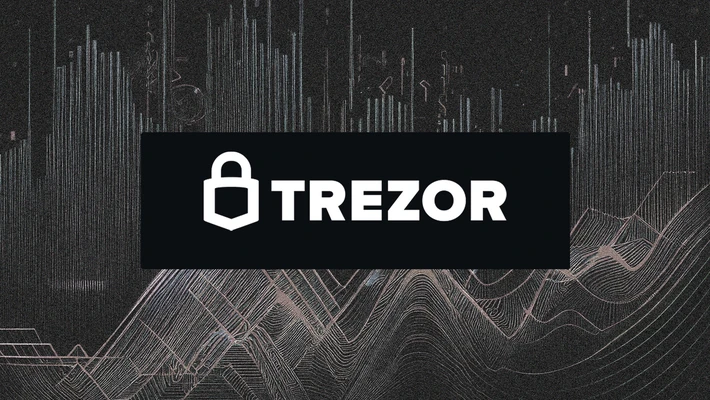
Trezor
Trezor is a well-known company in the crypto industry that specializes in manufacturing hardware wallets for storing digital assets.
About Trezor
| Foundation | 2013 |
| Headquarters | Prague, Czech Republic |
| Founders | Marek Palatinus and Pavol Rusnak |
| Revenue | $15.3 million |
| Products | Hardware wallets |
Trezor is a pioneer in the field of cryptocurrency hardware wallets. Famous figures in the crypto industry, Marek Palatinus and Pavol Rusnak, brought their experience in cryptography and software development to create the world's first cold wallet. Marek and Pavol aimed to make cryptocurrencies more accessible. Soon, the concept of a secure yet easy-to-use solution for managing cryptocurrencies was introduced. In fact, this became the company's core mission.
Trezor not only became the first hardware wallet company, but also set and firmly established standards for cryptocurrency hardware wallets. This helps the company remain a leader among rivals such as Ledger.
Although the company launched in 2013, the prototype of the first Trezor wallet appeared a year earlier. Marek Palatinus, Pavol Rusnak and Alena Vranova participated in its development. Marek and Pavol met while they were colleagues at the non-profit technology company BRMLabs in Prague. They came together under the common idea of finding a way to protect private keys in cryptocurrency wallets offline. Alena Vranova joined them later, bringing her CFO experience. They founded SatoshiLabs and started fundraising in 2013. The wallets gained popularity and in 2016, SatoshiLabs introduced a prototype for Trezor One. In 2018, the company released its next product, the Trezor Model T.
The Trezor project subsequently split off from SatoshiLabs, becoming a subsidiary of SatoshiLabs. SatoshiLabs includes not only Trezor, but also other companies such as Invity, Tropic Square, and Vexl. The current CEO of Trezor is Matěj Žák.
Products
Trezor hardware wallet became the leading product of the company. Now there are several types of the wallet on the market. They are designed to protect private keys from possible risks online and offline. For this purpose, Trezor stores private keys offline and confirms transactions in the device. It is also possible to use the Trezor device with other wallets. Trezor supports sending and receiving transactions, signing and verifying messages,
Trezor Model One
Is the first hardware wallet to be introduced. It is a small device, rather like a keychain. The device contains the data needed to store and trade cryptocurrency. It has a screen capable of displaying up to six lines of text and two buttons on the front panel that are used for menu navigation and text entry. It does not have a permanent internet connection. Connection to a computer is via a USB cable. The wallet is password protected and requires the user to enter a PIN to withdraw coins and send them to another wallet. It is compatible with Windows, Linux, Android, and Mac OS and supports 1200+ cryptocurrencies, including Bitcoin and Ethereum. The weight of the device is 12 grams.

Trezor Model T
This is an updated version of the Model One. It has similar features, but is complemented by a number of improvements. Model T has a more user-friendly LCD screen and supports 1400+ cryptocurrencies. It also has a MicroSD card port, making it more secure and convenient for data storage than the Trezor One. It also features Secure Device Input and weighs 22 grams.

Trezor Safe 3
The latest hardware wallet model. It was designed specifically for those new to the crypto industry. The wallet supports major cryptocurrencies like Bitcoin and Ethereum etc. It can be integrated with the Trezor desktop application. The product also features a tamper-resistant Secure Element hardware component that provides additional real-world protection and can operate in sub-zero temperatures.

Trezor offers more than just hardware wallets. Trezor also offers products for storing cryptocurrencies more securely.
Trezor Keep Metal
This is a device designed to protect seed phrases. Trezor Keep Metal is fire, water, and impact resistant. The device provides the most secure storage of seed phrases and is suitable for those who are prone to losing seed phrases on a piece of paper.

Trezor Model One vs. Trezor Model T: Which Is Better?
| Trezor Model T | Trezor Model One | Better is | |
| Price | $153 | $48 | Trezor Model One |
| Security |
CE and RoHS certification Shamir Backup |
CE and RoHS certification | Trezor Model T |
| Connectivity |
USB-C SD card |
USB-A | Trezor Model T |
| Supported cryptocurrencies | 1400+ coins and tokens | 1200+ coins and tokens | Trezor Model T |
| Connection | Computer, browser, Android and iOS | Computer, browser, Android and iOS | both |
| Screen | 1.54'' Touchscreen color LCD (240x240 pixels) | OLED (128x64 pixels) | Trezor Model T |
Best: Trezor Model T
This model is more suitable for those who prefer a comfortable screen, those who need a powerful processor to keep the wallet running smoothly, and those who own numerous variety of cryptocurrencies.
How to set up a wallet
- Getting started with your wallet requires you to set it up. The steps to set up the wallet are as follows:
- Connect the wallet to your computer via USB cable.
- Go to trezor.io/start and select the required wallet model.
- Download and install Trezor Bridge.
- Complete the installation by following the on-screen instructions.
Other method:
- Install the latest firmware version by visiting wallet.trezor.io and clicking on Install Latest Firmware.
- Once the firmware is installed, a welcome page will appear with the option to create a new wallet.
- Click on the Create button. The wallet will automatically create a unique seed phrase.
How to complete a transaction in the wallet
In order to perform a transaction, you need to perform the following steps:
- Connect the device and go to the account page in Trezor Wallet.
- Press the "Send" button.
- Select the necessary cryptocurrency to send and enter the required address.
- Set the desired amount or amount to send.
- Select the commission: low, average, or the highest. The speed of transaction processing depends on it.
- Confirm the transaction.
Security features of Trezor wallet
Trezor wallets are characterized by enhanced security. Here are some special features:
- The wallet alerts the user if the signature does not match the data that is stored by the company.
- Each device is equipped with an ultrasonic hardware seal.
- Private and public key transactions are verified with a PIN.
- The device is updated securely. It happens only after a successful firmware verification.
- The wallets support additional phrases: BIP39.
- Recovery and copying of seed phrases is also secure. A recovery phrase consists of 12–24 words unique for each device. Such a phrase allows restoring access to the wallet if the user has lost the physical device.
Still, things that are meant to improve wallet security also bring additional problems. For example, the fact that private keys are stored in isolated hardware makes them vulnerable to loss, breakage, or theft. A cold wallet is password protected, and whoever owns it has access to the physical device. Therefore, owners are more susceptible than ever to theft of the device itself.
There have also been cases where users have purchased fake Trezor devices on popular marketplaces, leading to the theft of their cryptocurrencies as these wallets contained malware. Moreover, Kraken Security Labs once discovered a way to extract any seed phrase from Trezor Model One and Trezor Model T.
Trezor Supported Coins
Trezor supports more than 8000 cryptocurrencies, including the most popular ones: Bitcoin, Ethereum, Monero, NEM, Dash, Cardano, Litecoin, XRP and others.
Pros and cons of Trezor wallet
Pros
- Color touchscreen available
- Built-in open source software
- Shamir backup is offered
- Highly secure offline storage.
- Affordable low-end model.
- Suitable for beginners.
- Trezor Suite makes it easy to track your portfolio.
- Good asset support.
Cons
- Does not support NFT and staking features.
- No Bluetooth connection or mobile app.
- Plastic case.
- Limited support for iOS devices and various browsers.
- Quickly become obsolete due to lack of update feature.
- Little support for layer 1 networks.
Investment
The company's website states that Trezor is an independent company, so it does not participate in venture capital investment so as not to jeopardize the security of its products.



